Pathophysiology: Hypertensive Patient with COPD Analysis
VerifiedAdded on 2022/09/16
|7
|1451
|16
Essay
AI Summary
This essay provides an in-depth analysis of Mrs. J's case, a 63-year-old patient with a complex medical history including hypertension, chronic heart failure, and chronic obstructive pulmonary disease (COPD). The essay begins by outlining Mrs. J's clinical presentation at the time of hospital admission, including her vital signs, and discusses how her medical history contributes to these manifestations. It then explores the nursing interventions implemented, such as the administration of furosemide, bronchodilators, and oxygen, and explains the rationale behind each intervention. The essay further delves into the cardiovascular conditions that can lead to heart failure, with specific attention to coronary heart disease and hypertension. It addresses the issue of polypharmacy, particularly in the elderly, and discusses nursing interventions to mitigate its risks. Finally, it suggests a multidisciplinary approach to Mrs. J's rehabilitation, emphasizing the importance of tobacco cessation and patient education to improve her overall health and independence. The essay references several scholarly articles to support its analysis.
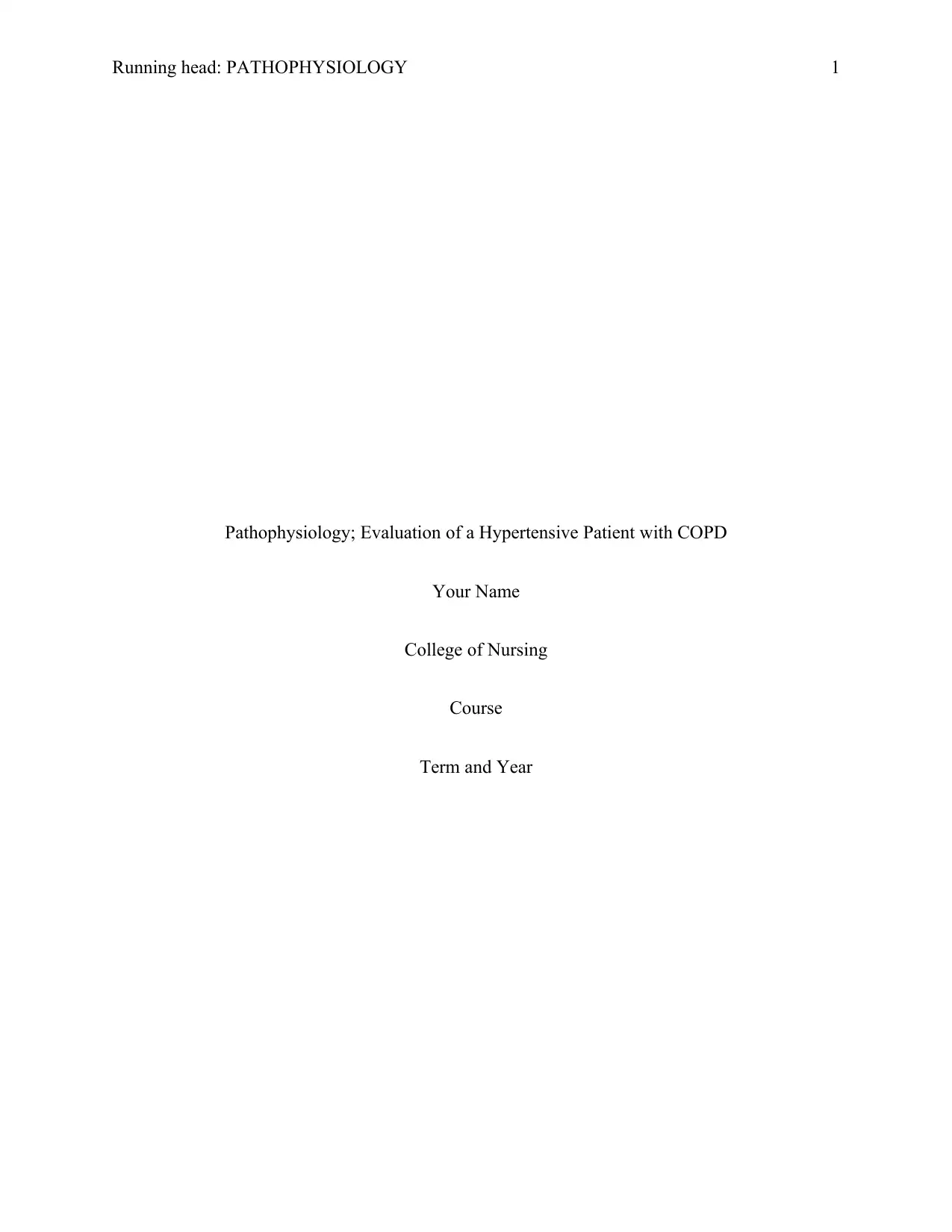
Running head: PATHOPHYSIOLOGY 1
Pathophysiology; Evaluation of a Hypertensive Patient with COPD
Your Name
College of Nursing
Course
Term and Year
Pathophysiology; Evaluation of a Hypertensive Patient with COPD
Your Name
College of Nursing
Course
Term and Year
Paraphrase This Document
Need a fresh take? Get an instant paraphrase of this document with our AI Paraphraser
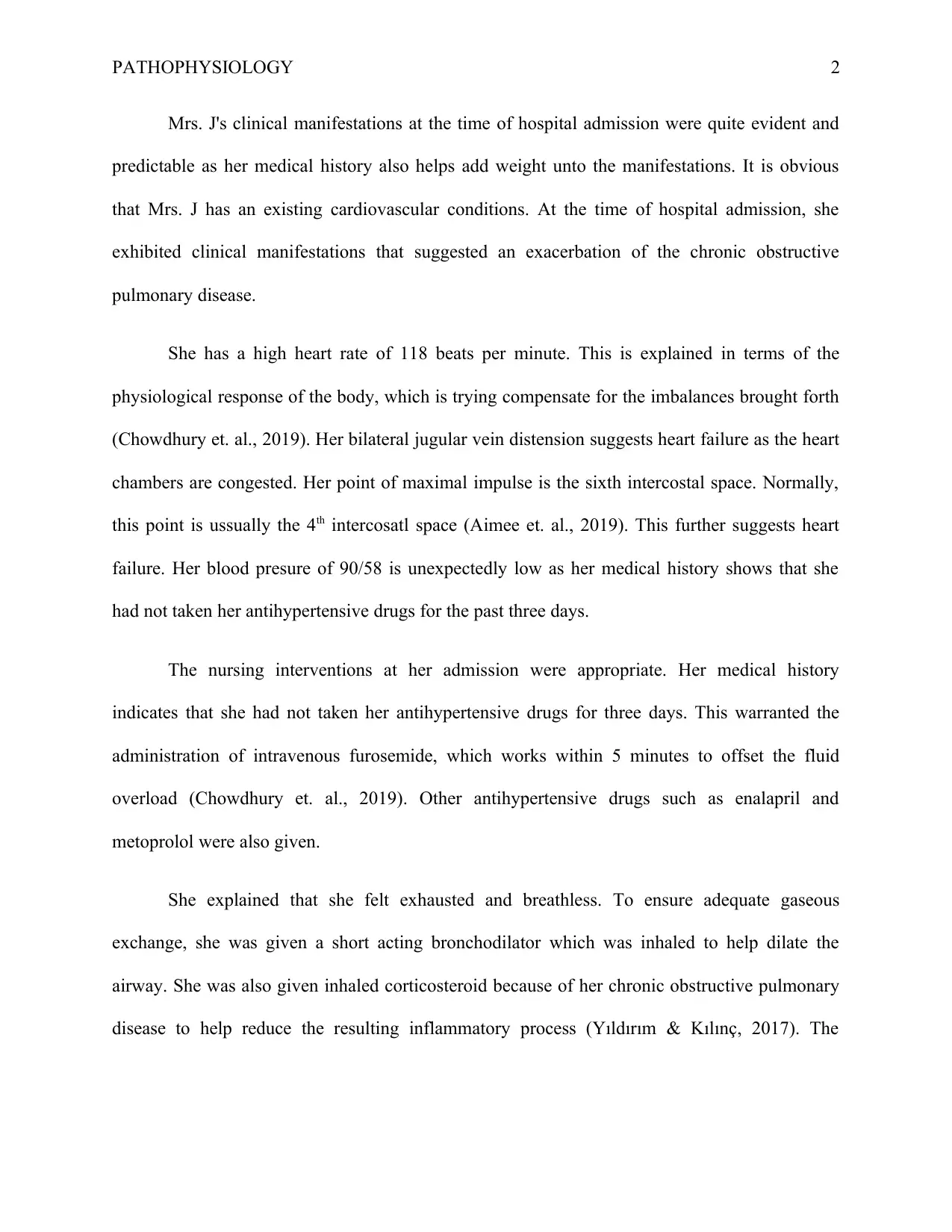
PATHOPHYSIOLOGY 2
Mrs. J's clinical manifestations at the time of hospital admission were quite evident and
predictable as her medical history also helps add weight unto the manifestations. It is obvious
that Mrs. J has an existing cardiovascular conditions. At the time of hospital admission, she
exhibited clinical manifestations that suggested an exacerbation of the chronic obstructive
pulmonary disease.
She has a high heart rate of 118 beats per minute. This is explained in terms of the
physiological response of the body, which is trying compensate for the imbalances brought forth
(Chowdhury et. al., 2019). Her bilateral jugular vein distension suggests heart failure as the heart
chambers are congested. Her point of maximal impulse is the sixth intercostal space. Normally,
this point is ussually the 4th intercosatl space (Aimee et. al., 2019). This further suggests heart
failure. Her blood presure of 90/58 is unexpectedly low as her medical history shows that she
had not taken her antihypertensive drugs for the past three days.
The nursing interventions at her admission were appropriate. Her medical history
indicates that she had not taken her antihypertensive drugs for three days. This warranted the
administration of intravenous furosemide, which works within 5 minutes to offset the fluid
overload (Chowdhury et. al., 2019). Other antihypertensive drugs such as enalapril and
metoprolol were also given.
She explained that she felt exhausted and breathless. To ensure adequate gaseous
exchange, she was given a short acting bronchodilator which was inhaled to help dilate the
airway. She was also given inhaled corticosteroid because of her chronic obstructive pulmonary
disease to help reduce the resulting inflammatory process (Yıldırım & Kılınç, 2017). The
Mrs. J's clinical manifestations at the time of hospital admission were quite evident and
predictable as her medical history also helps add weight unto the manifestations. It is obvious
that Mrs. J has an existing cardiovascular conditions. At the time of hospital admission, she
exhibited clinical manifestations that suggested an exacerbation of the chronic obstructive
pulmonary disease.
She has a high heart rate of 118 beats per minute. This is explained in terms of the
physiological response of the body, which is trying compensate for the imbalances brought forth
(Chowdhury et. al., 2019). Her bilateral jugular vein distension suggests heart failure as the heart
chambers are congested. Her point of maximal impulse is the sixth intercostal space. Normally,
this point is ussually the 4th intercosatl space (Aimee et. al., 2019). This further suggests heart
failure. Her blood presure of 90/58 is unexpectedly low as her medical history shows that she
had not taken her antihypertensive drugs for the past three days.
The nursing interventions at her admission were appropriate. Her medical history
indicates that she had not taken her antihypertensive drugs for three days. This warranted the
administration of intravenous furosemide, which works within 5 minutes to offset the fluid
overload (Chowdhury et. al., 2019). Other antihypertensive drugs such as enalapril and
metoprolol were also given.
She explained that she felt exhausted and breathless. To ensure adequate gaseous
exchange, she was given a short acting bronchodilator which was inhaled to help dilate the
airway. She was also given inhaled corticosteroid because of her chronic obstructive pulmonary
disease to help reduce the resulting inflammatory process (Yıldırım & Kılınç, 2017). The
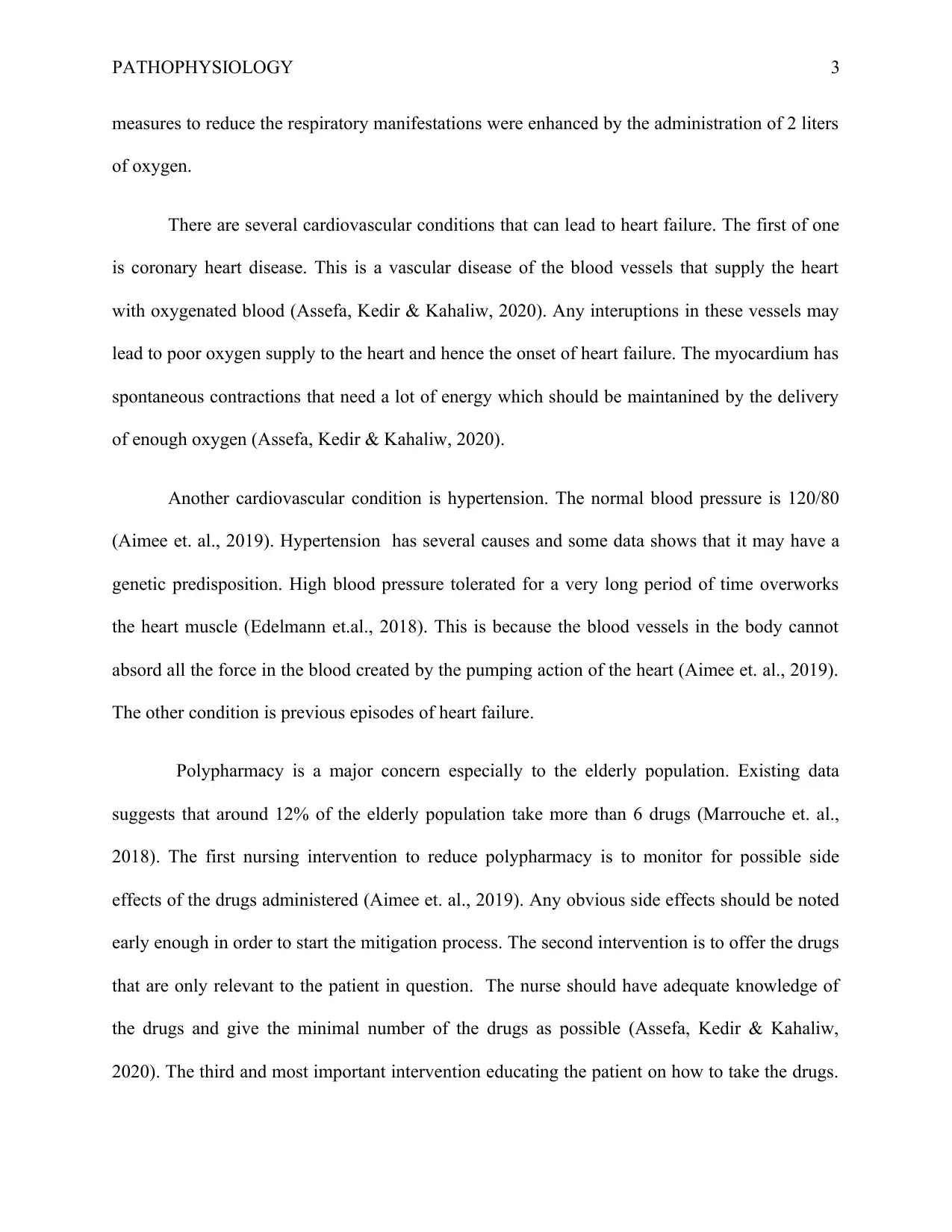
PATHOPHYSIOLOGY 3
measures to reduce the respiratory manifestations were enhanced by the administration of 2 liters
of oxygen.
There are several cardiovascular conditions that can lead to heart failure. The first of one
is coronary heart disease. This is a vascular disease of the blood vessels that supply the heart
with oxygenated blood (Assefa, Kedir & Kahaliw, 2020). Any interuptions in these vessels may
lead to poor oxygen supply to the heart and hence the onset of heart failure. The myocardium has
spontaneous contractions that need a lot of energy which should be maintanined by the delivery
of enough oxygen (Assefa, Kedir & Kahaliw, 2020).
Another cardiovascular condition is hypertension. The normal blood pressure is 120/80
(Aimee et. al., 2019). Hypertension has several causes and some data shows that it may have a
genetic predisposition. High blood pressure tolerated for a very long period of time overworks
the heart muscle (Edelmann et.al., 2018). This is because the blood vessels in the body cannot
absord all the force in the blood created by the pumping action of the heart (Aimee et. al., 2019).
The other condition is previous episodes of heart failure.
Polypharmacy is a major concern especially to the elderly population. Existing data
suggests that around 12% of the elderly population take more than 6 drugs (Marrouche et. al.,
2018). The first nursing intervention to reduce polypharmacy is to monitor for possible side
effects of the drugs administered (Aimee et. al., 2019). Any obvious side effects should be noted
early enough in order to start the mitigation process. The second intervention is to offer the drugs
that are only relevant to the patient in question. The nurse should have adequate knowledge of
the drugs and give the minimal number of the drugs as possible (Assefa, Kedir & Kahaliw,
2020). The third and most important intervention educating the patient on how to take the drugs.
measures to reduce the respiratory manifestations were enhanced by the administration of 2 liters
of oxygen.
There are several cardiovascular conditions that can lead to heart failure. The first of one
is coronary heart disease. This is a vascular disease of the blood vessels that supply the heart
with oxygenated blood (Assefa, Kedir & Kahaliw, 2020). Any interuptions in these vessels may
lead to poor oxygen supply to the heart and hence the onset of heart failure. The myocardium has
spontaneous contractions that need a lot of energy which should be maintanined by the delivery
of enough oxygen (Assefa, Kedir & Kahaliw, 2020).
Another cardiovascular condition is hypertension. The normal blood pressure is 120/80
(Aimee et. al., 2019). Hypertension has several causes and some data shows that it may have a
genetic predisposition. High blood pressure tolerated for a very long period of time overworks
the heart muscle (Edelmann et.al., 2018). This is because the blood vessels in the body cannot
absord all the force in the blood created by the pumping action of the heart (Aimee et. al., 2019).
The other condition is previous episodes of heart failure.
Polypharmacy is a major concern especially to the elderly population. Existing data
suggests that around 12% of the elderly population take more than 6 drugs (Marrouche et. al.,
2018). The first nursing intervention to reduce polypharmacy is to monitor for possible side
effects of the drugs administered (Aimee et. al., 2019). Any obvious side effects should be noted
early enough in order to start the mitigation process. The second intervention is to offer the drugs
that are only relevant to the patient in question. The nurse should have adequate knowledge of
the drugs and give the minimal number of the drugs as possible (Assefa, Kedir & Kahaliw,
2020). The third and most important intervention educating the patient on how to take the drugs.
⊘ This is a preview!⊘
Do you want full access?
Subscribe today to unlock all pages.

Trusted by 1+ million students worldwide
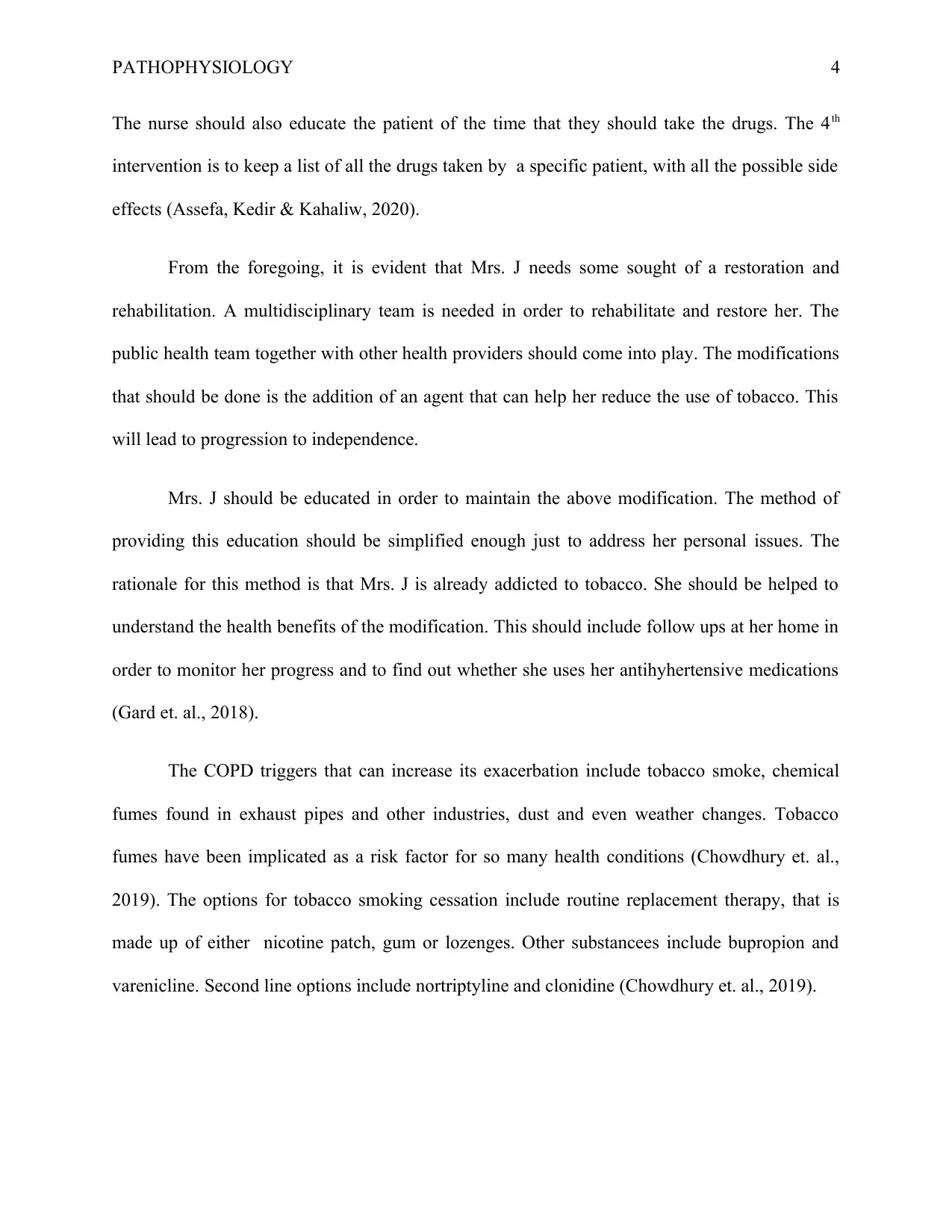
PATHOPHYSIOLOGY 4
The nurse should also educate the patient of the time that they should take the drugs. The 4th
intervention is to keep a list of all the drugs taken by a specific patient, with all the possible side
effects (Assefa, Kedir & Kahaliw, 2020).
From the foregoing, it is evident that Mrs. J needs some sought of a restoration and
rehabilitation. A multidisciplinary team is needed in order to rehabilitate and restore her. The
public health team together with other health providers should come into play. The modifications
that should be done is the addition of an agent that can help her reduce the use of tobacco. This
will lead to progression to independence.
Mrs. J should be educated in order to maintain the above modification. The method of
providing this education should be simplified enough just to address her personal issues. The
rationale for this method is that Mrs. J is already addicted to tobacco. She should be helped to
understand the health benefits of the modification. This should include follow ups at her home in
order to monitor her progress and to find out whether she uses her antihyhertensive medications
(Gard et. al., 2018).
The COPD triggers that can increase its exacerbation include tobacco smoke, chemical
fumes found in exhaust pipes and other industries, dust and even weather changes. Tobacco
fumes have been implicated as a risk factor for so many health conditions (Chowdhury et. al.,
2019). The options for tobacco smoking cessation include routine replacement therapy, that is
made up of either nicotine patch, gum or lozenges. Other substancees include bupropion and
varenicline. Second line options include nortriptyline and clonidine (Chowdhury et. al., 2019).
The nurse should also educate the patient of the time that they should take the drugs. The 4th
intervention is to keep a list of all the drugs taken by a specific patient, with all the possible side
effects (Assefa, Kedir & Kahaliw, 2020).
From the foregoing, it is evident that Mrs. J needs some sought of a restoration and
rehabilitation. A multidisciplinary team is needed in order to rehabilitate and restore her. The
public health team together with other health providers should come into play. The modifications
that should be done is the addition of an agent that can help her reduce the use of tobacco. This
will lead to progression to independence.
Mrs. J should be educated in order to maintain the above modification. The method of
providing this education should be simplified enough just to address her personal issues. The
rationale for this method is that Mrs. J is already addicted to tobacco. She should be helped to
understand the health benefits of the modification. This should include follow ups at her home in
order to monitor her progress and to find out whether she uses her antihyhertensive medications
(Gard et. al., 2018).
The COPD triggers that can increase its exacerbation include tobacco smoke, chemical
fumes found in exhaust pipes and other industries, dust and even weather changes. Tobacco
fumes have been implicated as a risk factor for so many health conditions (Chowdhury et. al.,
2019). The options for tobacco smoking cessation include routine replacement therapy, that is
made up of either nicotine patch, gum or lozenges. Other substancees include bupropion and
varenicline. Second line options include nortriptyline and clonidine (Chowdhury et. al., 2019).
Paraphrase This Document
Need a fresh take? Get an instant paraphrase of this document with our AI Paraphraser

PATHOPHYSIOLOGY 5
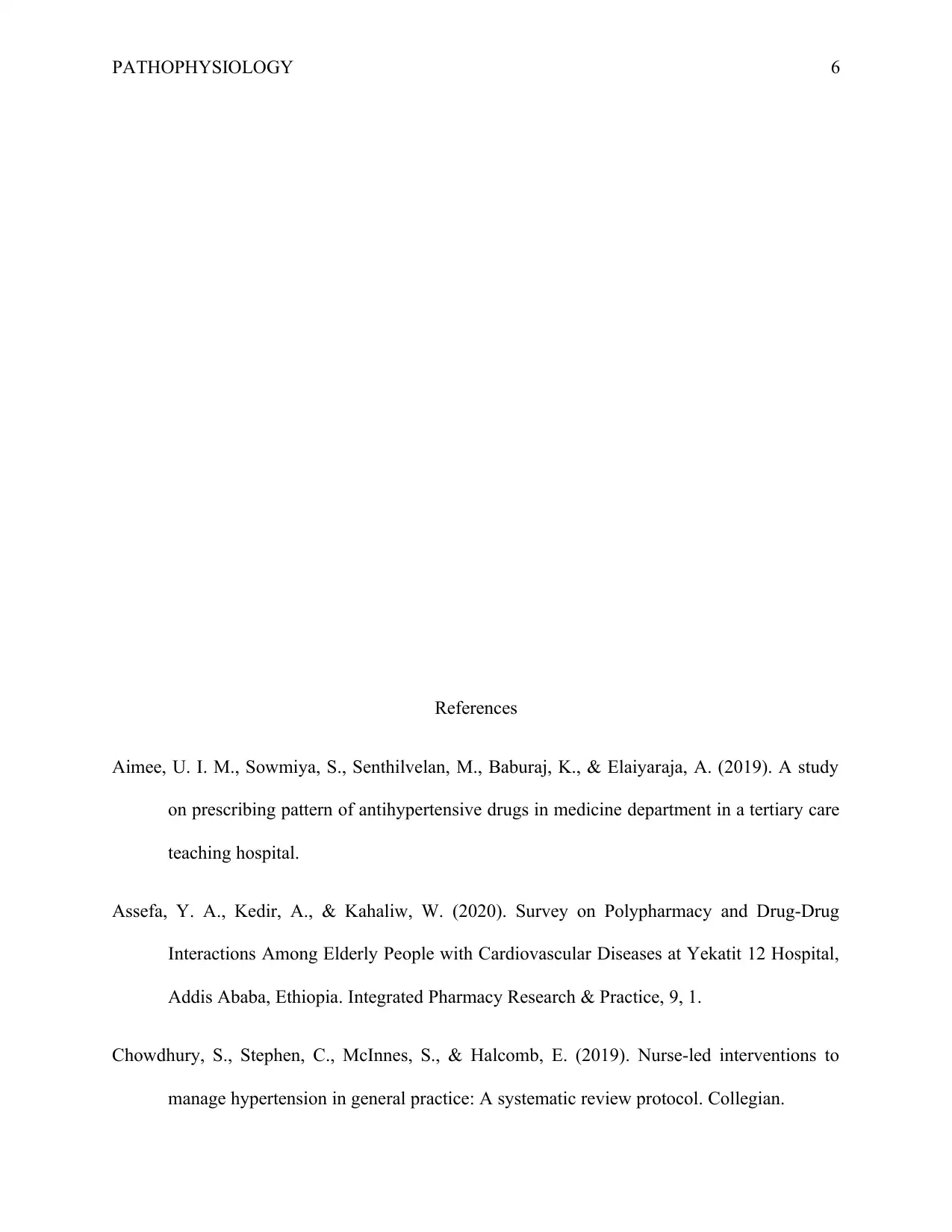
PATHOPHYSIOLOGY 6
References
Aimee, U. I. M., Sowmiya, S., Senthilvelan, M., Baburaj, K., & Elaiyaraja, A. (2019). A study
on prescribing pattern of antihypertensive drugs in medicine department in a tertiary care
teaching hospital.
Assefa, Y. A., Kedir, A., & Kahaliw, W. (2020). Survey on Polypharmacy and Drug-Drug
Interactions Among Elderly People with Cardiovascular Diseases at Yekatit 12 Hospital,
Addis Ababa, Ethiopia. Integrated Pharmacy Research & Practice, 9, 1.
Chowdhury, S., Stephen, C., McInnes, S., & Halcomb, E. (2019). Nurse-led interventions to
manage hypertension in general practice: A systematic review protocol. Collegian.
References
Aimee, U. I. M., Sowmiya, S., Senthilvelan, M., Baburaj, K., & Elaiyaraja, A. (2019). A study
on prescribing pattern of antihypertensive drugs in medicine department in a tertiary care
teaching hospital.
Assefa, Y. A., Kedir, A., & Kahaliw, W. (2020). Survey on Polypharmacy and Drug-Drug
Interactions Among Elderly People with Cardiovascular Diseases at Yekatit 12 Hospital,
Addis Ababa, Ethiopia. Integrated Pharmacy Research & Practice, 9, 1.
Chowdhury, S., Stephen, C., McInnes, S., & Halcomb, E. (2019). Nurse-led interventions to
manage hypertension in general practice: A systematic review protocol. Collegian.
⊘ This is a preview!⊘
Do you want full access?
Subscribe today to unlock all pages.

Trusted by 1+ million students worldwide
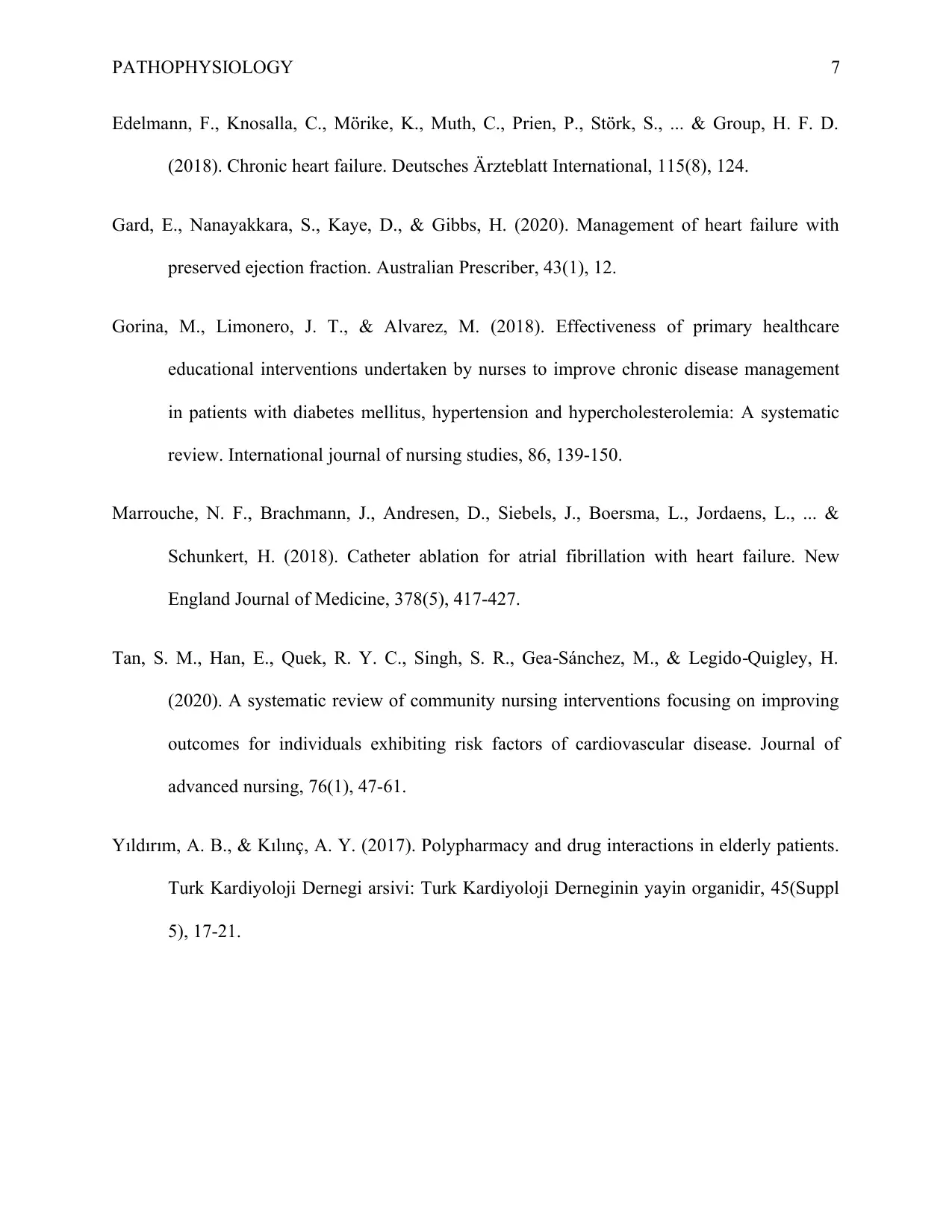
PATHOPHYSIOLOGY 7
Edelmann, F., Knosalla, C., Mörike, K., Muth, C., Prien, P., Störk, S., ... & Group, H. F. D.
(2018). Chronic heart failure. Deutsches Ärzteblatt International, 115(8), 124.
Gard, E., Nanayakkara, S., Kaye, D., & Gibbs, H. (2020). Management of heart failure with
preserved ejection fraction. Australian Prescriber, 43(1), 12.
Gorina, M., Limonero, J. T., & Alvarez, M. (2018). Effectiveness of primary healthcare
educational interventions undertaken by nurses to improve chronic disease management
in patients with diabetes mellitus, hypertension and hypercholesterolemia: A systematic
review. International journal of nursing studies, 86, 139-150.
Marrouche, N. F., Brachmann, J., Andresen, D., Siebels, J., Boersma, L., Jordaens, L., ... &
Schunkert, H. (2018). Catheter ablation for atrial fibrillation with heart failure. New
England Journal of Medicine, 378(5), 417-427.
Tan, S. M., Han, E., Quek, R. Y. C., Singh, S. R., Gea Sánchez, M., & Legido Quigley, H.‐ ‐
(2020). A systematic review of community nursing interventions focusing on improving
outcomes for individuals exhibiting risk factors of cardiovascular disease. Journal of
advanced nursing, 76(1), 47-61.
Yıldırım, A. B., & Kılınç, A. Y. (2017). Polypharmacy and drug interactions in elderly patients.
Turk Kardiyoloji Dernegi arsivi: Turk Kardiyoloji Derneginin yayin organidir, 45(Suppl
5), 17-21.
Edelmann, F., Knosalla, C., Mörike, K., Muth, C., Prien, P., Störk, S., ... & Group, H. F. D.
(2018). Chronic heart failure. Deutsches Ärzteblatt International, 115(8), 124.
Gard, E., Nanayakkara, S., Kaye, D., & Gibbs, H. (2020). Management of heart failure with
preserved ejection fraction. Australian Prescriber, 43(1), 12.
Gorina, M., Limonero, J. T., & Alvarez, M. (2018). Effectiveness of primary healthcare
educational interventions undertaken by nurses to improve chronic disease management
in patients with diabetes mellitus, hypertension and hypercholesterolemia: A systematic
review. International journal of nursing studies, 86, 139-150.
Marrouche, N. F., Brachmann, J., Andresen, D., Siebels, J., Boersma, L., Jordaens, L., ... &
Schunkert, H. (2018). Catheter ablation for atrial fibrillation with heart failure. New
England Journal of Medicine, 378(5), 417-427.
Tan, S. M., Han, E., Quek, R. Y. C., Singh, S. R., Gea Sánchez, M., & Legido Quigley, H.‐ ‐
(2020). A systematic review of community nursing interventions focusing on improving
outcomes for individuals exhibiting risk factors of cardiovascular disease. Journal of
advanced nursing, 76(1), 47-61.
Yıldırım, A. B., & Kılınç, A. Y. (2017). Polypharmacy and drug interactions in elderly patients.
Turk Kardiyoloji Dernegi arsivi: Turk Kardiyoloji Derneginin yayin organidir, 45(Suppl
5), 17-21.
1 out of 7
Related Documents
Your All-in-One AI-Powered Toolkit for Academic Success.
+13062052269
info@desklib.com
Available 24*7 on WhatsApp / Email
![[object Object]](/_next/static/media/star-bottom.7253800d.svg)
Unlock your academic potential
Copyright © 2020–2025 A2Z Services. All Rights Reserved. Developed and managed by ZUCOL.





